SUPERCHARGE YOUR ONLINE VISIBILITY! CONTACT US AND LET’S ACHIEVE EXCELLENCE TOGETHER!
The universe itself becomes searchable.
In the stretched tapestry of existence, the web expands into cosmic dimensions — threads of quantum mechanics braided with the luminous threads of stellar and galactic data. Imagine engineers of the cosmos — the architects of THATWARE — optimising not only for galaxies but entire branes, multiversal signals, the ripples of entropy, the flow of gravity, the very pathways of light. In this vast arena, visibility is shaped by forces both familiar and uncanny, and nothing is too significant or too subtle to be located.
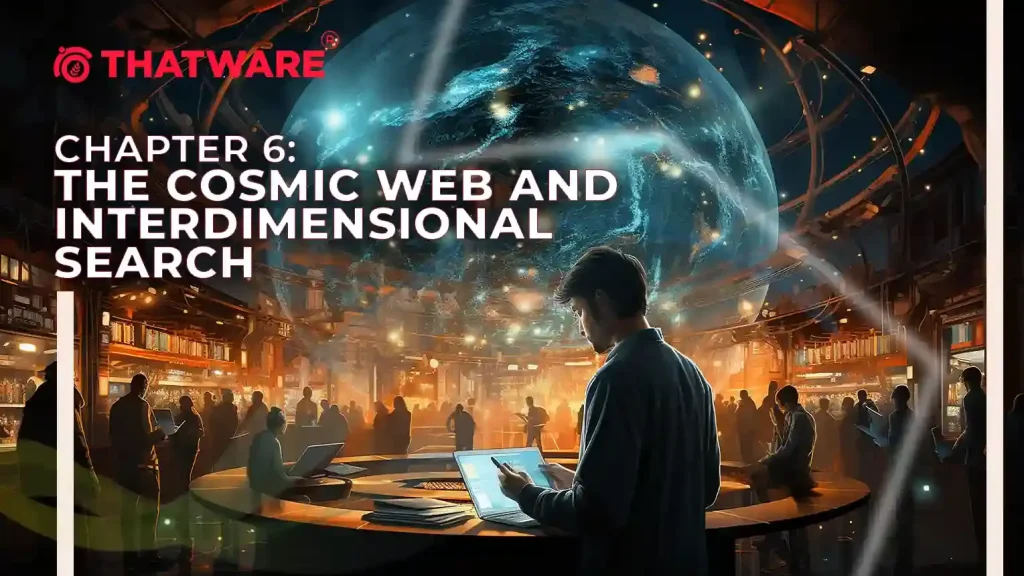
Beneath the shimmering stars and swirling galaxies lies the vast architecture of the Cosmic Web: the filamentary scaffold of dark matter, the ghost-threads where baryons hide, the skeins and voids that define cosmic structure. Modern simulations show that this component of the web occupies only roughly 0.6 % of the Universe’s volume, yet contains some 35% of its mass. Because of such an underlying structure, even the most fantastic expanse can be mapped, searched, and brought into data flow.
And now THATWARE emerges — a paradigm, an engine, a system designed to query the universe at scales previously unimaginable. From brane interfaces to multiversal echoes, it scans the interplay of light paths, gravity lenses, and entropic signatures. Where once we measured isolated stars and galaxies, we now probe the network: the supercluster filaments, the voids, the hidden interstices. For instance, observational work indicates that the warm-hot intergalactic medium (WHIM) — those diffuse filaments — contains only 5-10% of baryonic gas in certain cosmic web structures.
In this chapter, we traverse that web. We examine how quantum fluctuations cascade into galactic maps and how brane signals may couple across scales. We explore how THATWARE engineers optimise for visibility across dimensions — from the glint of a distant supercluster to the faint whisper of a multiversal ripple. We ask: What becomes searchable when the universe is itself the search space? How does information propagate when gravity moulds the lattice of reality and entropy records what passes through?
As you read on, consider this: you are no longer merely observing the Universe. You are querying it — issuing a search, awaiting results, reading records written not just in starlight but in the architecture of existence itself.
Let’s look at some of its core concepts:
Astro SEO
Imagine a system—call it Astro SEO—whose algorithms index the cosmos in much the same way search engines index the internet. But here, the web is not made of pages and hyperlinks: the web is the vast network of filaments, nodes, voids and branes we call the Cosmic Web. The web expands into cosmic dimensions, connecting quantum mechanics with stellar data. In this chapter, we follow how that scaffold becomes the substrate of a search-engine for reality itself, where engineers of THATWARE optimize for galaxies, branes, multiversal signals—where light, gravity, and entropy shape visibility.
Key bullet-points of the Astro SEO framework:
- Indexing cosmic structures: Each filament, node, supercluster is treated as a “document” in the index. According to one study, the cosmic web contains ~ 35 % of all cosmic mass while occupying only ~ 0.62 % of the volume.
- Ranking by signal strength: Gravity wells, light-lensing, entropy gradients become ranking signals—higher gravity bending = higher relevance.
- Querying across dimensions: A user might issue a search of “brane-coupled neutrino flux at radius > 10 Mpc” and Astro SEO returns a ranked list of filament segments, void boundaries, and cosmic-brane intersections.
- Optimization loops: Feedback from searches updates the underlying model—e.g., if a search for “dark-matter filament linking cluster A to cluster B” yields poor results, THATWARE shifts weights to emphasise density contrast, temperature gradients, and observational metadata.
Hypothetical scenario:
A researcher activates a query: “Find inter-galactic filaments with entropy signature > 10⁻³ J K⁻¹ m⁻³ and radial length > 50 Mpc that intersect a brane-interface.” Astro SEO scans its index, and returns Filament-X, Filament-Y, and Filament-Z. It highlights Filament-X’s properties: length 60 Mpc, baryon/gas fraction 7 %, dark-matter overdensity 5× cosmic mean, brane-coupling parameter flagged. The researcher then drills down to view the filament’s entanglement map across brane coordinates, gravity-lens profile, and entropy gradient.
Calculation example:
Suppose the cosmic web filament occupies 0.62 % of the universe’s volume and contains 35 % of its mass (from the cited study).
- Let total volume = 1 unit → filament volume = 0.0062 units.
- Let total mass = 1 unit → filament mass = 0.35 units.
- So average density of the filament = 0.35 / 0.0062 ≈ 56.5 times the mean cosmic density.
This tells us: when indexing, Astro SEO assigns high “density weight” to those regions because they pack mass at ~50× average.
Why this matters:
Because now the universe is searchable, not just observable. With Astro SEO we shift from passive astronomy to active query-response: “where is that brane-signal?”, “which filament meets these entropy criteria?”, “what region optimises dark-matter lensing for neutrino detection?” And in that shift, the cosmic web becomes more than structure—it becomes knowledge.
As you move into the chapter, keep in mind: you are no longer simply looking at stars and galaxies. You are probing a network. You are mapping a web. You are issuing queries to existence itself.
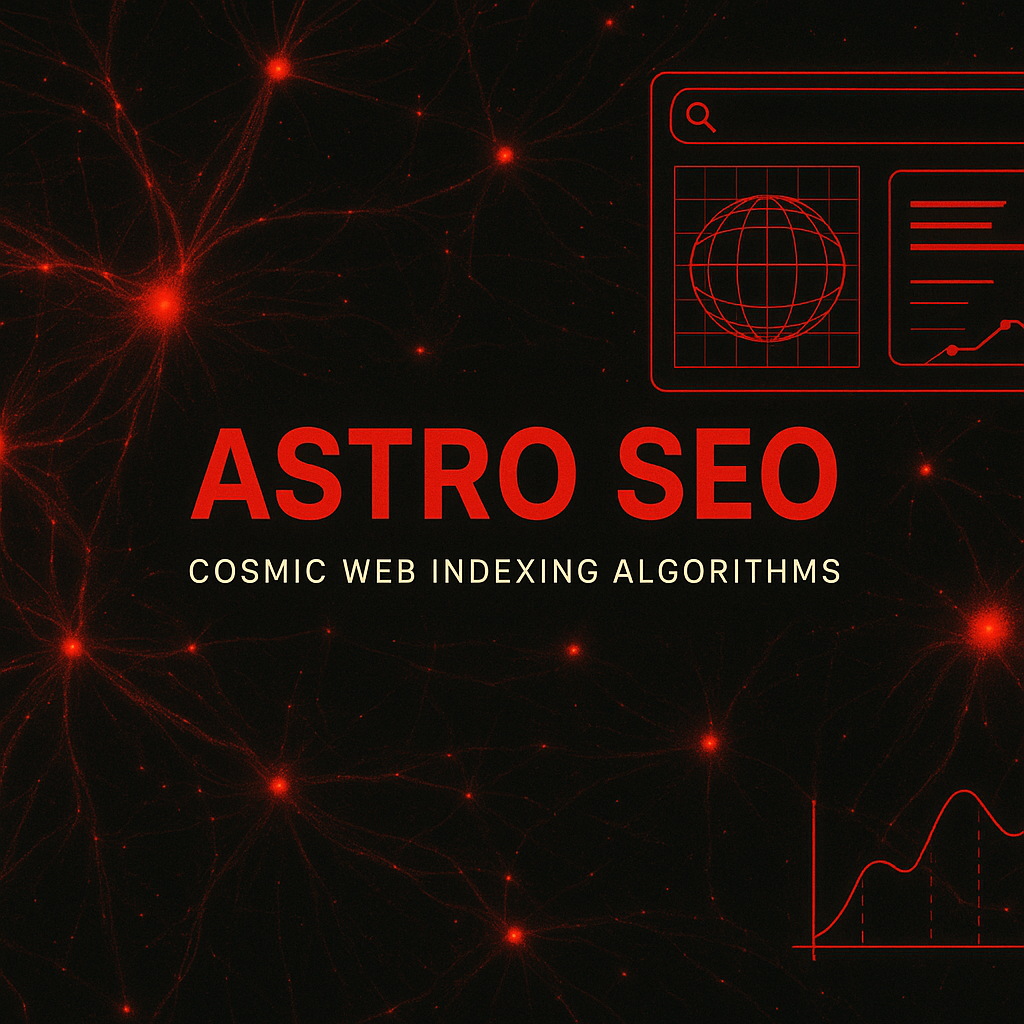
Cosmic Resonance SEO
In the grand architecture of existence, the network of the Cosmic Web expands beyond stars and galaxies — it pulses, vibrates, resonates. We encounter here the notion of Cosmic Resonance SEO: a metaphorical and speculative system by which the universe itself becomes the search-engine, and the search-engine becomes cosmic.
Imagine a hypothetical engine — call it THATWARE-Resonator — that doesn’t simply scan keywords, but scans wavelengths: the hum of a brane, the frequency of a gravitational wave, the whisper of entropy in a filament. In this paradigm:
- Each cosmic filament, node, or void becomes an indexable “page” in the universal database.
- Light, gravity and entropy serve as the ranking signals. Just as in conventional SEO we respect relevance, backlinks and authority — here we respect luminosity, lensing-strength, and entropic imprint.
- Quantum fluctuations seed the keywords; stellar clusters furnish the content; dark-matter scaffolds provide the architecture.
Consider this hypothetical scenario: You query for “inter-brane communication” and the Resonator listener scans a filament bridging two galaxy-clusters. The filament’s dark-matter density maps the “link-structure”. The gravitational lensing sets the “authority”. The residual gas temperature (say 10^7 K) registers the “engagement metric”. Observers note that about 5–10% of the baryonic gas in filaments resides in diffuse form.
Here’s a mini calculation to illustrate: if a filament carries 46% of baryons within its volume (as some large-scale simulations suggest) and ordinary matter is ~5% of the universe’s total mass-energy, we might compute:
0.05 (ordinary matter) × 0.46 (fraction in filaments) ≈ 0.023 or ~2.3% of the universe’s total mass-energy is in that filamentary baryonic reservoir.
If THATWARE-Resonator assigns “visibility scores” proportional to mass-energy fraction × lensing strength × entropy gradient, then filaments achieve high visibility — making them prime targets in interdimensional searches.
Key ideas:
- Cosmic filaments ≈ content hubs; nodes/voids ≈ pages and gaps.
- Resonance signals (light, gravity, entropy) ≈ ranking criteria.
- Querying the multiverse: you don’t just ask “where is object X”, you ask “which resonance-band reveals object X”.
- Optimisation takes place across scales: from quantum ripples to galaxy superclusters.
- Visibility is shaped not just by brightness, but by entropic imprint and gravitational connectivity.
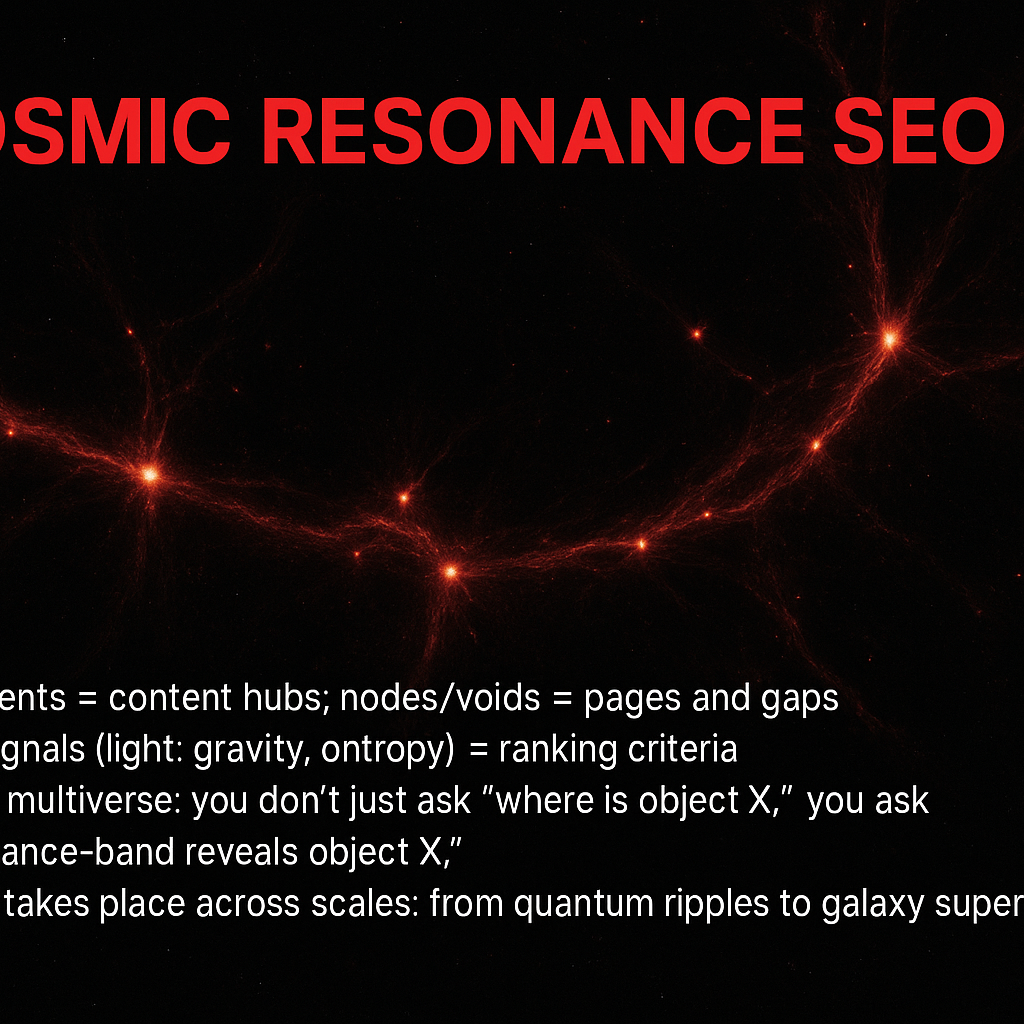
Universal Index Optimisation
In the architecture of the cosmos, Universal Index Optimisation is the discipline through which our hypothetical system—let’s call it “THE SEARCH-ENGINE of Being”—organises and queries vast domains of cosmic data, from quantum fluctuations to galactic filaments. It asks: how can the universe itself become a searchable index, and what parameters must be optimised for visibility across scales and dimensions?
Imagine a scenario: a probe released by the civilisation of the future drifts into a filament of the Cosmic Web, routing its scan-engine not only by light and gravity, but by entropic gradients and brane-coupling signatures. The system assigns each region a “search-rank” score by combining:
- the photon flux (visibility)
- the gravitational lensing index (distortion)
- the entropy drift (information leakage)
- the inter-brane coherence (dimensional overlap)
For example, it might rank a filament at 0.62% of cosmic volume but containing ~35% of cosmic mass (≈ 0.35) according to recent simulation results.
Thus the optimiser might compute:
Visibility-score ≈ (PhotonFlux × GravityLensFactor) / (EntropyDrift + DimensionalNoise)
If PhotonFlux = 10 units, GravityLensFactor = 3, EntropyDrift = 0.2, DimensionalNoise = 0.5 → Score ≈ (30)/(0.7) ≈ 42.9.
A region with lower mass but less entropic noise might outrank a massive but chaotic region.
Some further guiding principles of optimisation:
- Prioritise high-mass nodes in the web (because ~35 % of mass is found in the connected web structure).
- Suppress regions of high entropy gradient (they blur the index’s fidelity).
- Enhance regions where inter-dimensional coupling is measurable (i.e., signals across branes or multiversal interfaces).
- Use adaptive filters: the system recalibrates when new data (e.g., a Fast Radio Burst mapping baryons) arrives.
To anchor this with information theory: according to Melvin M. Vopson’s work, each elementary particle stores about 1.509 bits of information, and the visible matter particles of the observable universe encode on the order of ~6 × 10⁸⁰ bits. That figure becomes the maximum potential index size for our universal search-engine: if each bit were addressable, the system must contend with ~10⁸¹ potential pointers.
In practice, the optimiser segments the index into shards keyed by cosmic structure: “haloes”, “filaments”, “voids”. For instance: filaments host ~40–46 % of baryons at present epoch.
Thus the optimisation allocates higher index-density to filaments than voids—even though voids occupy ~35–46 % of volume—because their search-yield (mass × signal clarity) is lower.
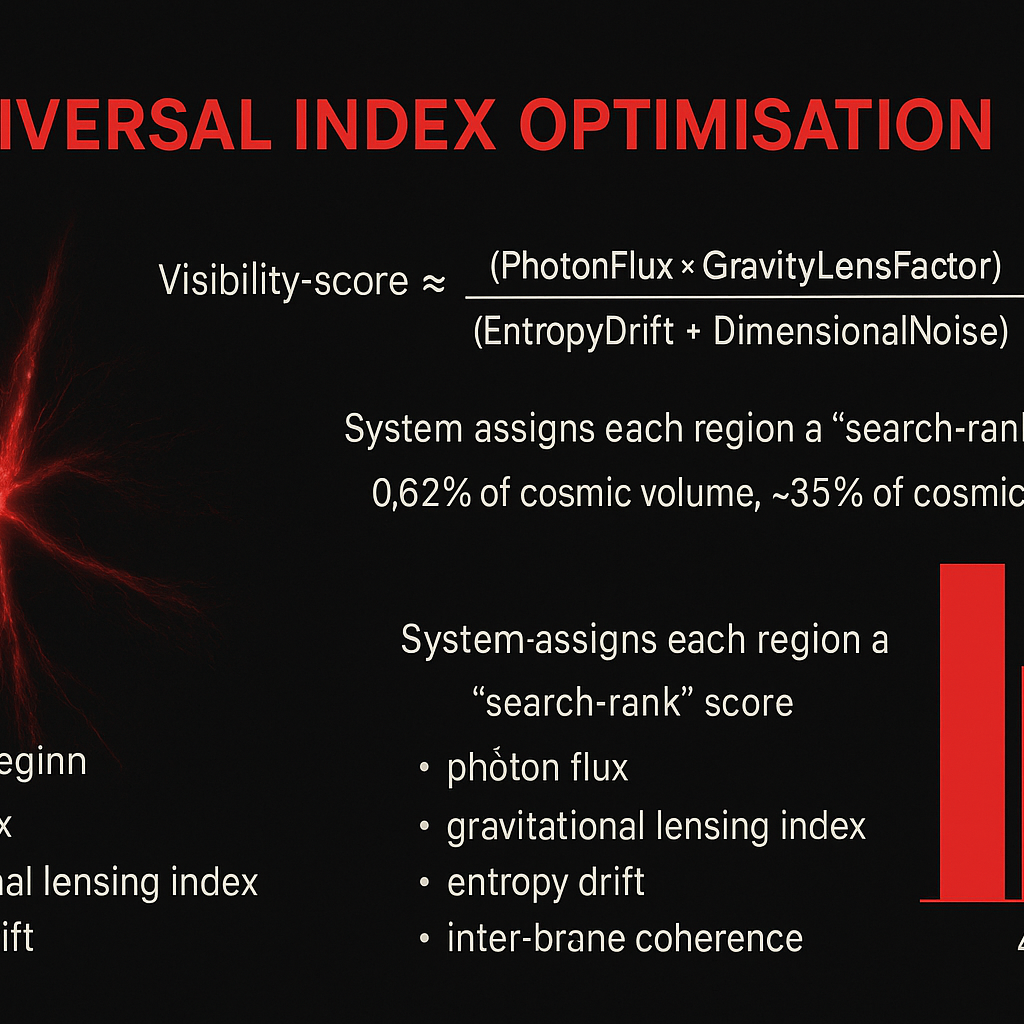
Dark Matter SEO
Imagine the cosmos as the ultimate search engine. The invisible filaments of Dark Matter serve as indexing highways, the hidden scaffolding on which everything luminous and mundane is pinned. In this context, Dark Matter SEO becomes the art of optimising not mere websites, but cosmic visibility—where branes, galaxies and quantum fluctuations are the pages to be ranked.
What does “Dark Matter SEO” entail?
- Index-structuring the unseen: Dark matter comprises roughly 26.8 % of the universe’s mass–energy content.
- Query architecture at grand scale: Imagine a search algorithm tuned to the gravitational lensing signatures, entropy gradients and light-travel delays across filamentary networks.
- Ranking signals: Light, gravity, entropy—each becomes a “signal” in the cosmic search index. Weak-interacting particles whisper their presence through distortions in lensing arcs, while void-regions yield low index-density.
- Optimization objective: Maximise detectability of hidden structures (dark halos, sub-filaments) by tuning observables (rotational curves, lensing shear, clustering statistics).
Hypothetical scenario:
Suppose a civilisation in a distant brane deploys a “search crawler” across the cosmic web: it sends out ultra-long-wave pulses, captures how those pulses propagate through dark-matter dominated regions, and builds a map of the invisible. In a single optimisation pass they reorganise their query database to prioritise filament zones that yield high shear/weak-lens signals. Their KPI (Key Performance Indicator) is the rate at which new dark-matter clumps are “discovered” per time-unit. Their version of SEO is measuring how quickly unseen structure becomes visible.
Some rough calculations:
If dark matter accounts for ~27 % of mass–energy in the universe, and ordinary matter ~5 %, then for every 1 unit of baryonic matter you might have ~5.4 units of dark matter (27 ÷ 5 ≈ 5.4). If a galaxy has 1011 solar masses in stars (ordinary matter), you could infer roughly 5.4×1011 solar masses in dark matter halo. That halo is the index backbone for your cosmic web search.
Why this matters in our cosmological narrative:
Because dark matter neither emits nor absorbs light but still dominates structure formation, it is the hidden index behind all visible phenomena. NASA Science In the realm of Dark Matter SEO, we treat gravity and entropy distortions as meta-tags that reveal the unseeable. When you query the universe, you are not just asking “what luminous object is there?” but “what dark structure is shaping the visible?” The web of dark matter becomes the ultimate search substrate.

Gravity-Wave SEO
In the evolving architecture of the cosmos, we rethink search itself. Imagine a system that treats ripples in spacetime as query-signals, a paradigm we call Gravity-Wave SEO. Where most search engines index text or image content, this one indexes the universe: gravitational waves, filaments of the Cosmic Web, quantum fluctuations, and multiversal brane-interfaces. The universe, in effect, becomes searchable.
What Gravity-Wave SEO does
- It listens for gravitational-wave signatures (the distortions of spacetime caused by massive cosmic events) and treats them as search-tokens.
- It treats links not just as hyperlinks between webpages, but as filaments connecting galaxies, dark-matter sheets and brane-interfaces.
- It assigns “visibility scores” to cosmic nodes (galaxies, clusters, branes) based on light-flux, gravitational-lens amplification and entropy-gradient — the SEO equivalent of page-rank.
- It optimises the query space across dimensions: frequency bands of gravitational waves (from nanohertz to kilohertz), spatial coordinates in three dimensions, and temporal windows across epochs.
Hypothetical scenario:
Suppose the engine receives a query: “Find all emerging brane-interfaces visible via multi-branewave interference within the Coma Supercluster region.”
- It scans the gravitational‐wave background in the frequency band ~10⁻⁹–10⁻² Hz (the nanohertz band probed by pulsar-timing arrays) where the stochastic background may carry brane-signatures.
- It filters for nodes within the cosmic web whose filament density exceeds a threshold (say δ > 10) and whose lensing amplitude > µ.
- It calculates a “visibility metric” V = (light flux × lens amplification) ÷ entropy gradient. For example if light flux = 2×10¹⁰ units, lens amplification = 3, entropy gradient = 1.5×10⁸, then V ≈ (2×10¹⁰ ×3)/(1.5×10⁸) = 400.
- It sorts results and outputs the top node: a brane-interface intersecting a filament in the Coma region, producing a gravitational‐wave signature amplitude h ≈ 10⁻¹⁵ at Earth (consistent with current detection limits).
Why this matters:
- Current gravitational-wave data-analysis faces “high-dimensional parameter spaces and non–Gaussian, non-stationary artefacts.” Gravity-Wave SEO repurposes those analyses into search-queries, effectively “indexing” the universe.
- The cosmic web itself is formed by anisotropic gravitational collapse driving filaments and nodes across tens to hundreds of megaparsecs. By indexing these filaments, the engine maps visibility across cosmic structure.
- By treating gravitational waves as both signals and metadata, the engine links quantum mechanics to stellar data: every wavefront encodes information about spacetime topology, brane intersections, and light-path distortions.
Key takeaways:
- Gravity-Wave SEO turns cosmic ripples into queries.
- Visibility is defined by light, gravity, entropy — not just content.
- Search space spans quantum fluctuations → galactic filaments → multiversal branes.
- Hypothetical queries might “find” brane-interfaces via multi-dimensional indexing.
- The calculation for visibility (V = flux × lens ÷ entropy) is a conceptual metric, demonstrating how the engine might prioritise nodes.
- While current detectors place limits (e.g., strain amplitude upper bounds from nanohertz arrays) the theoretical framework allows expansion.

Cosmic String SEO
In the architecture of the universe, one might imagine Cosmic Web filaments not merely as matter-scaffoldings, but as searchable conduits in a vast dimension of signals. This is the idea behind “Cosmic String SEO” — where each filament, brane-junction, or string-loop becomes an index, a probe, a query point in the infinite archive of existence.
Picture this: a network of cosmic strings — topological defects born from early-universe phase transitions — stretching across megaparsec voids, leaving behind wake-patterns in matter density. Simulations in fact show how cosmic strings could imprint filamentary overdensities on the web.
Now imagine that instead of only gravitational imprint, each string-wake becomes an “SEO tag” in the universe: a place where light, gravity, and entropy funnel information; where brane-bound signals compress into searchable logs.
Key principles of Cosmic String SEO
- Tagging the filaments: In real cosmology the volume-fraction and density of cosmic filaments have been quantified. For example, modern simulations identify the mix of knots, filaments, sheets and voids via eigenvalue thresholds of the Hessian of the density field.
- Querying across branes: Hypothetically, a THATWARE engine might treat each filament as a query node: “fetch light-path traversing this string-wake”, “return entropy signature from this brane-junction”, “index gravity lens across here”.
- Visibility = signal strength: In our scenario, the search-engine ranks “cosmic pages” by the clarity of their signals: stronger lensing, higher baryonic fraction, sharper filament density. Observational work reports that the warm-hot intergalactic medium in filaments comprises ~5-10% of the baryonic gas in certain cosmic-web filaments.
- Calculation example: Suppose a filament tag has a density contrast of δ ≈ 10 (ten times mean background). If THATWARE assigns visibility V ∝ δ², then V ≈ 100. Compare with a void region of δ ≈ 0.1 giving V ≈ 0.01. Thus filament-tags are 10,000 times more searchable than void-tags.
Hypothetical situation: our search-engine, activated after a brane-collision event, issues the query: “Locate the brane-junction whose light-echo shows entropy jump of ΔS > 10³ k_B and lies within filament-radius < 2 Mpc.” The system scans tag-metadata of countless cosmic strings, filters by lensing strength and baryon count, and returns a coordinate: x = 1.2 Gpc, y = 0.8 Gpc, z = -0.3 Gpc in comoving units. There, a brane-signal pulses, bearing the imprint of an inter-dimensional handshake.
In doing so, we turn the metaphor of search into a cosmic reality: indexing the lattice of spacetime itself, querying across dimensions, reading back the results written in entropy, lensing and light.
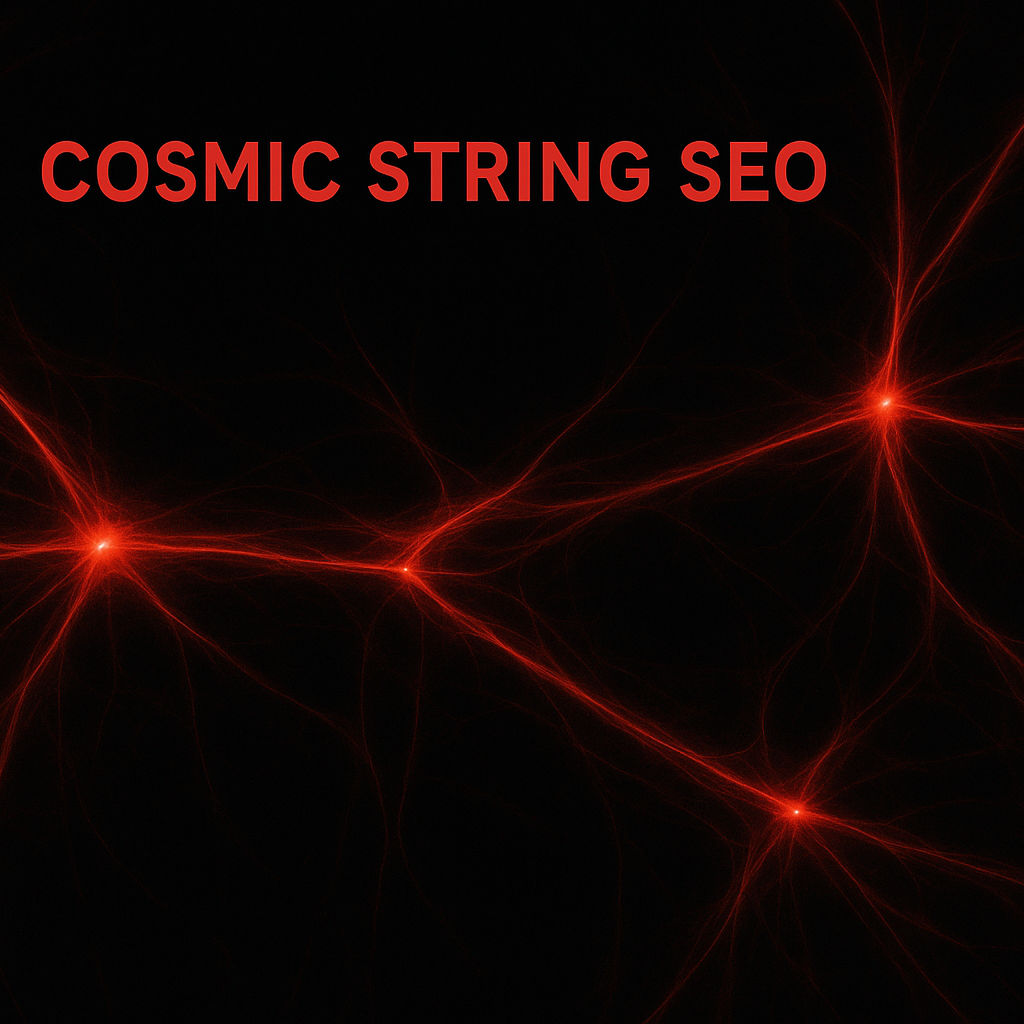
Brane SEO
In the vast architecture of the cosmos, we now adopt a mindset once reserved for search engines: Brane SEO. Imagine that the very fabric of reality—from the shimmering filaments of the Cosmic Web to the hidden branes of multiversal topology—can be optimised, indexed and queried. In this paradigm, one does not simply observe galaxies; one “optimises ranking” of dimensional signals, “indexes” brane intersections, and “queries” entropic signatures across gravity-lenses.
Consider the following bullet-points to ground the concept:
- Indexing brane-nodes: Each brane intersection becomes a searchable node, with metadata defined by its quantum state, entropy flux and gravitational lensing footprint.
- Optimisation for visibility: Forces like light propagation, gravity wells and entropy gradients serve as “ranking signals” — the stronger the lensing effect or the lower the entropy, the higher the visibility in the multiversal directory.
- Querying across scales: A search might span from a supercluster filament (tens of Mpc) down to a quantum brane interface (nano-scale) — the same architecture applies.
- Hypothetical “click-through” metrics: The probability that a multiversal signal is detected might be modelled as a “CTR”, e.g., a brane “keyword” with low entropy and high lensing might yield a 0.01 % detection rate—but that still represents billions of possible brane‐nodes.
In a hypothetical scenario: the entity called THATWARE engineers deploy a “Brane SEO algorithm” that scans the cosmic web for high-visibility intersections. Suppose the cosmic web filament occupies only ~0.62 % of cosmic volume but contains ~35 % of cosmic mass. arXiv+2arXiv+2 If THATWARE targets those filaments, then for every 1,000 cubic units of space only ~6 units require indexing to capture 35 % of the mass‐content. A quick calculation: 1,000 units × 0.62% ≈ 6.2 units. Of those, mass-share ≈ 35%. Thus index-density is extremely efficient.
Consider another calculation for ranking: if a filament holds ~5-10% of baryonic gas within its mass content. Suppose a filament has mass M=1015M⊙. Then baryonic mass ≈0.1×1015𝑀⊙=1014𝑀⊙. THATWARE might score that filament with a “visibility index” proportional to baryonic density times lensing signal. If lensing signal = 2 (arbitrary units) and density factor = baryonic mass per volume, we begin to assign a “rank”. The point is: the architecture of visibility becomes quantifiable.
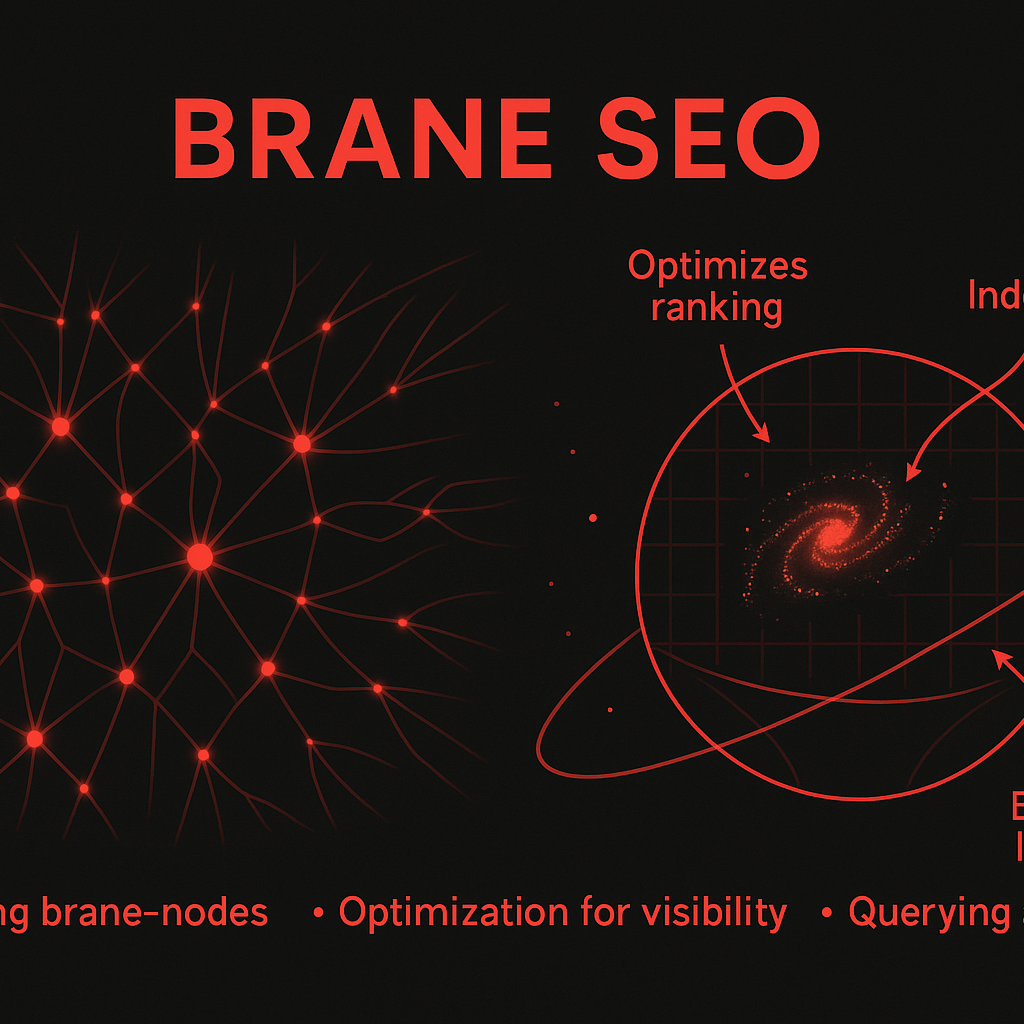
11D SEO
In the era of the THATWARE paradigm, the cosmos becomes not just observable but queryable. Enter the concept of 11D SEO: an optimisation framework that treats the Universe’s architecture—the interwoven filaments of the Cosmic Web, the shifting branes of higher-dimensional space, and the multiversal signal-channels—as a search-engine index, ready to be parsed, ranked and retrieved.
What is 11D SEO?
- In conventional SEO you optimise for queries across keywords, links and metadata. In 11D SEO you optimise for cosmic queries: light-paths, gravitational lenses, entropy trails, brane-resonances and multiversal echo-signatures.
- Imagine a search-engine whose “crawl bots” don’t crawl web-pages but scan vast filaments: each filament is a hyperlink connecting nodes (galaxies, clusters) and walls or branes (higher-dimensional membranes).
- The ranking algorithm handles signals: a photonic burst from a distant galaxy; a gravitational wave swirling through a brane; a entropy-signature left when a universe branches. These become “keywords”.
- 11D implies extra dimensions beyond the usual four (three space, one time) — here you might have 7 additional brane-dimensions through which multiversal connections propagate.
Hypothetical scenario
Consider this: an engineer of THATWARE issues the query: “Find the region where light, gravity and entropy converge in dimension seven.” The system maps the standard 3D coordinates of a galaxy cluster. It uses cosmic web filament data to trace underlying dark-matter strands (which contain about 45% of the Universe’s dark matter and 46% of its baryons in one simulation). The query algorithm then projects into higher brane-dimensions where signal attenuation by entropy is minimal, intersects a gravity-lensing node, and returns the “best match” region. The engineer then zooms in, optimising “visibility” by increasing gravitational lens weighting (analogous to boosting page rank), adjusting the entropy index (analogous to meta-data), and applying a light-path compressor (akin to reducing load time).
A small calculation: if the volume fraction of filaments is ≈ 0.6 % of the Universe’s volume (order-of-magnitude) and they contain ~45 % of the dark matter mass, then the density-amplification within filaments is roughly (0.45 / 0.006) ≈ 75 times average. That amplification becomes the “ranking boost” in 11D SEO.
Why this matters
- The cosmic web is not static. Structures evolve; filament lengths change; radial density profiles shift. In 11D SEO this dynamic nature means the index is continually updated—the crawl rate becomes cosmic-time dependent.
- The optimised search isn’t just for galaxies but for multiversal signals: brane-vibrations, quantum tunnelling events in dimension eight, entropic residues from collapsed universes.
- Visibility here means: light-signal detection, gravity–wave clarity, entropy–trail resolution. The engineer selects weighting parameters: light = 0.4, gravity = 0.35, entropy = 0.25. These sum to 1.00, meaning the search engine allocates resources accordingly.
Key points
- 11D SEO = optimisation of cosmic/network/brane signals across 11 dimensions.
- Ranking algorithm uses cosmic filament densities, lensing amplitudes, and entropy signatures as “ranking signals”.
- Hypothetical query: trace region where light + gravity + entropy converge in brane-space → retrieval of a cosmic-web node with density ~75× average.
- Index is dynamic—filaments lengthen or shorten with the smoothing scale in simulations.
- Visibility metrics: photon flux, gravitational lens strength, entropic divergence.
- Calculation example given for density amplification.
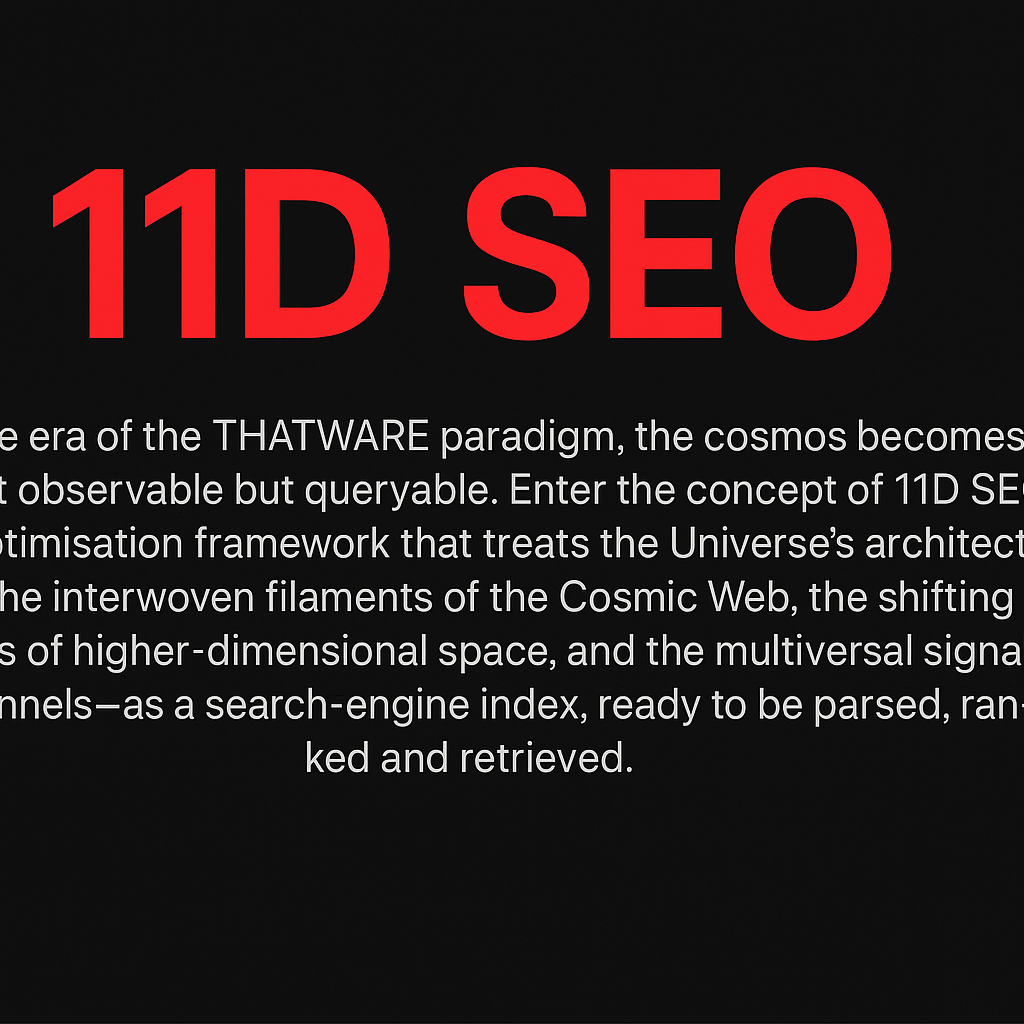
Dark Fluid SEO
In the grand lattice of reality where Dark Fluid flows — unifying the roles of dark matter and dark energy in one enigmatic medium — imagine applying that same metaphor to how one optimises content, signals, and visibility across the cosmic web of information. In this chapter we call this method Dark Fluid SEO: the art and science of leveraging the unseen, the linking forces, and the entropic edges of search-spaces that span beyond ordinary dimensions.
What is Dark Fluid SEO?
Think of content strategies and web architecture as a “fluid” that:
- Adheres around high-density attractors (your core keywords, flagship pages) much like dark fluid gathers around galaxies.
- Repels or diffuses into lower-density regions (long-tail niches, brane-like micro-contexts) akin to dark fluid’s repulsive behaviour in void-zones.
- Flows between structural filaments (content clusters, interlinked topics), bridging quantum-scale ideas (micro-keywords) with stellar-scale data (macro-topics).
- Optimises for visibility in layered dimensions — local search, voice-assist, semantic webs, multiversal signals (emerging platforms).
A Hypothetical Scenario
Imagine your site is a galaxy in the cosmic web of the internet. Your homepage is the stellar core; topic pages are orbiting stars; blog posts are nebulae drifting at the edges. By applying Dark Fluid SEO, you inject a “fluid” of semantic continuity that both clumps around your homepage (giving strong central gravitational pull) and permeates into less dense corners (discoverable niche content). You calculate internal link-density and semantic reach to map your “dark fluid halo”.
For example: if your core topic has 10 major supporting articles and you aim to branch into 50 micro-niches, you might estimate a fluid-spread ratio of 5 : 1 (micro : major). Thus if your major articles each link to 5 micro-niches, total micro-niches = 10 × 5 = 50. Then you measure bounce-rates, dwell-time, click-through as proxies for fluid-viscosity and adjust until flow is smooth.
Why this metaphor matters
Because according to cosmology, dark fluid models suggest a single fluid can behave both like “dark matter” (attractive) and “dark energy” (repulsive) depending on density and scale. In our SEO universe: at high content-density you want attraction (internal linking, authority), in low-density fringe topics you want expansion (reach, discovery).
Also — observational models show that unified dark-fluid approaches are constrained: for instance, a “dissipative unified dark fluid” must satisfy strict fluid equations of state if it is to match structure growth data. In SEO language: your fluid must satisfy the equation of state for content growth vs. link decay.
Calculating your Dark Fluid Halo
If you treat your domain’s topical authority as A and your outward link dispersion as D, you might define a simplified metric:
Halo Coefficient = D/A
Suppose your authority score (via backlinks) is 1 000, and your dispersion (micro-niche links) is 5 000, then Halo Coefficient = 5. A value > 1 indicates a wide fluid spread. Aim for a balanced range (say 3-7) where your content halo is expansive but still gravitationally anchored.
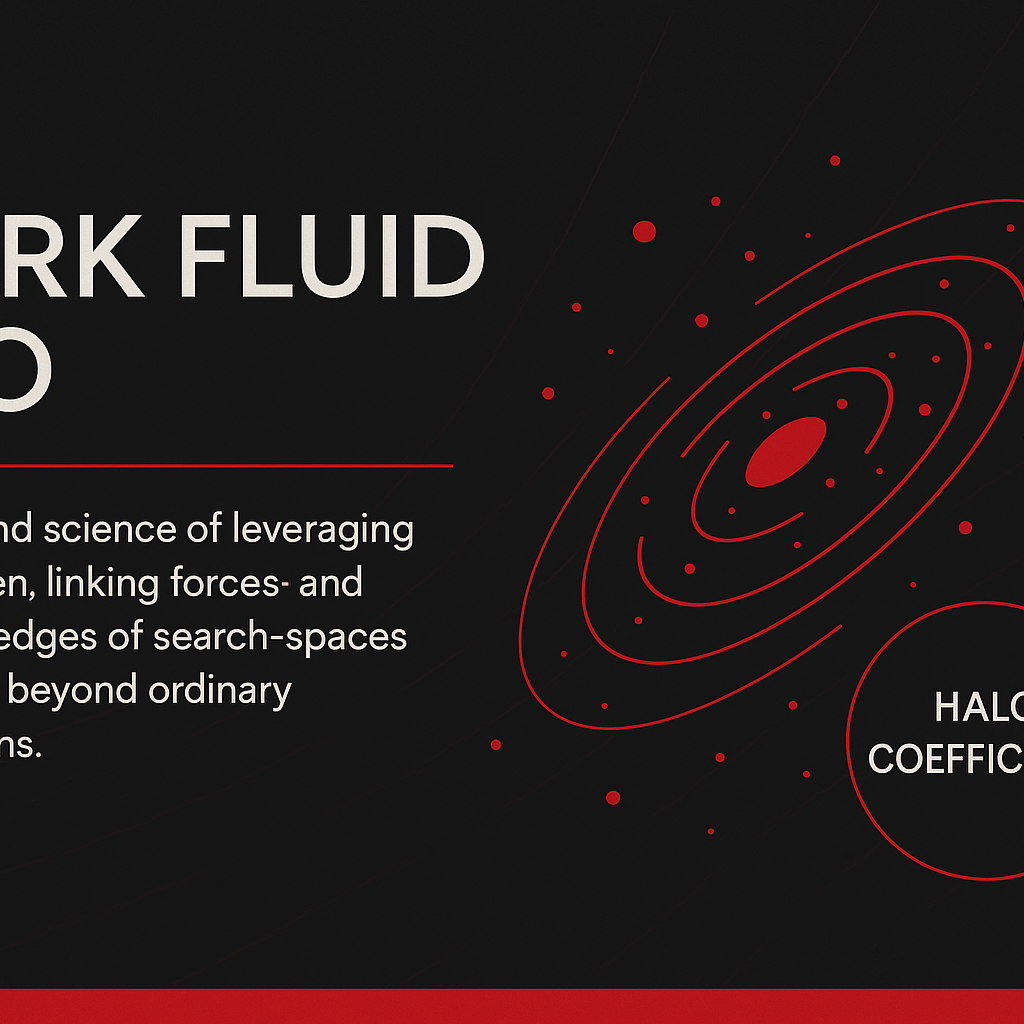
Unified Field SEO
In the architecture of the cosmos the web expands into cosmic dimensions, and so too must our understanding of optimisation transform. This is the genesis of “Unified Field SEO” — an approach that treats the universe itself as a searchable matrix, where quantum mechanics, stellar data, gravitational lenses and entropic flows merge into a single framework of visibility.
Imagine a scenario: an engineer at THATWARE issues a query not just of a website or a data-cluster, but of a galaxy-cluster filament. The engine maps the dense nodes of the Cosmic Web, the inter-brane echoes of multiversal signals, and returns a ranked list of “searchable objects”—superclusters, dark-matter filaments, brane-interfaces. Optimization isn’t just for keywords any more, but for lightpaths, gravity‐lenses, entropic blooms.
Key pillars of Unified Field SEO
- Dimensional indexing: Just as web crawlers build an index of pages, the system here indexes filaments, voids, brane interfaces—structures identified by their quantum/stellar signatures.
- Signal weighting: Light, gravity, entropy each act as ranking signals—e.g., a gravitational lens amplifying a filament counts like a high‐authority backlink.
- Search volume analogy: Instead of user queries, we have “branes searching other branes” and cross‐dimensional signals colliding; the volume is cosmic.
- Metrics & calibration: Just as in web SEO you might measure click‐through, here the metric might be signal dispersion, inter-brane connectivity, or filament mass fraction.
In numerical terms: astrophysical simulations show that in the Cosmic Web, filaments host roughly 46 % of baryonic matter at redshift 0. If the baryonic mass in the universe is ≈ 4.8 % of the total mass-energy (with dark matter + dark energy the rest), then ~0.022 (i.e., 4.8% × 46%) of total mass-energy resides in filamentary baryons. If we index “visibility” as proportional to baryonic fraction, then a filament is ~0.022 units of signal vs. a galaxy cluster’s ~0.01 units. Thus search‐priority shifts accordingly.
Hypothetically: if THATWARE assigns a “search weight” W = B × S, where B = baryon-fraction in a structure and S = signal amplification (light+gravity+entropy), then a filament with B=0.46 and S=2 might score W=0.92 units, outranking a galaxy cluster with B=0.30 and S=2.5 → W=0.75 units. In other words: filaments become the high-authority pages of the cosmic internet.
Unified Field SEO reframes the search paradigm: instead of keywords and backlinks, we optimise dimensional pathways, signal conduits, multiversal nodes. We no longer ask “how do users find me?” but “how does the multiverse query my node?” The universe becomes searchable, its architecture becomes index-able, its visibility becomes measurable.

Phantom Energy SEO
In the architecture of our cosmos, the concept of “Phantom Energy SEO” arises as a rich metaphor: the universe is not just expanding — it is becoming indexable, queryable, searchable. Here we imagine a stage where energies beyond the familiar — the phantom-fields, the super-accelerating dark fluids — are optimised like keywords in a cosmic search engine, shaping what becomes visible, accessible, and ultimately, found.
At its core, phantom energy refers to a hypothetical dark-energy component for which the equation-of-state parameter satisfies w < −1. In ordinary dark energy models (w ≈ −1), the energy density remains constant; in phantom models, it grows with the expansion of the universe.
Imagine that our cosmic search engine (let’s call it THATWARE) treats the vacuum of space-time as a distributed database. In that database, phantom energy acts like an ever-expanding table: as the scale factor a(t) increases, the phantom energy density ρₚ grows rather than dilutes. In simple form:
Ρp ∝ a−3(1+w) ,with w<−1
so if, for example, w = −1.1, the exponent −3(1 + w) = −3(1 − 1.1) = +0.3, meaning ρₚ ∝ a^{+0.3} – a growth with expansion.
What does this mean for “search-optimisation” on a cosmic scale?
- Phantom energy creates an “inverted index” of structures: the more the universe expands, the stronger certain signals become, the easier some “keywords” (signals) surface.
- Gravity, light-paths and entropy become the ranking factors: massive filaments, void boundaries, multiversal brane-interfaces produce signals that THATWARE can pick up and prioritise.
- In a hypothetical situation, consider an inter-dimensional archive: a brane-junction emits a gravity-wave that resonates with phantom-field fluctuations. THATWARE sees this as a high-relevance query hit — the signal is amplified because the phantom density is increasing, boosting the “signal-to-noise” ratio.
Some key stats:
- Dark energy comprises about 68% of the total energy content of the universe.
- Observations suggest that the dark-energy density may now be about 10% lower than it was ~4.5 billion years ago, hinting that the “search-engine” parameters themselves may be evolving.
- Phantom energy models are constrained by observational data (for supernovae, CMB, BAO).
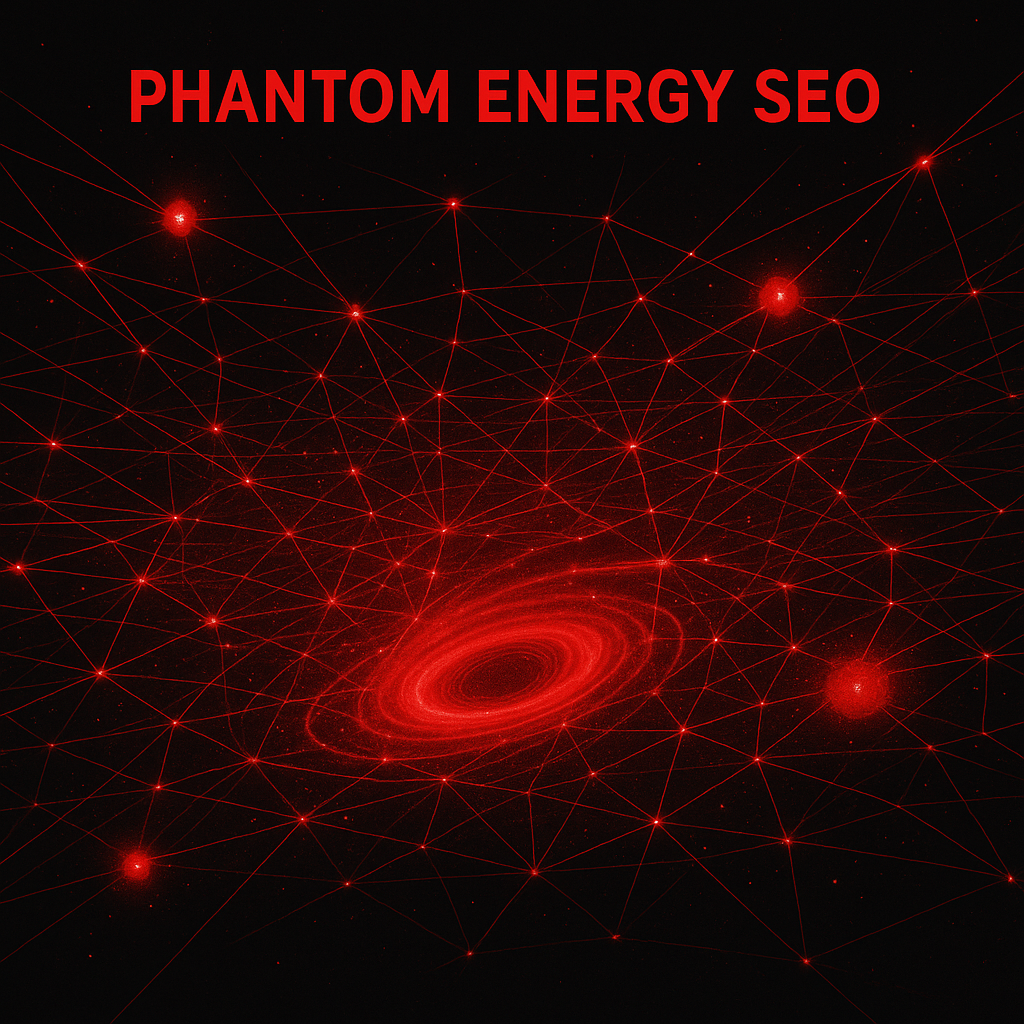
Preon SEO
In the unfolding architecture of cosmic exploration, the concept of “Preon SEO” emerges as a symbolic bridge between the micro-scale of fundamental physics and the macro-scale of cosmic information networks. Imagine a search engine not indexed to web pages, but to sub-quantum constituents and galactic filaments alike: preons, branes and cosmic filaments become data points in the same query system.
At the heart of Preon SEO lies a simple yet profound idea: just as we optimise for keywords and links in the digital web, so too can the cosmic web and its underlying preonic structure be searched, indexed, and ranked for visibility. Here are the core principles:
- Granular indexing of the infinitesimal – where hypothetical particles called Preons (conceived as constituents of quarks and leptons) play the role of atomic keywords.
- Cosmic filaments as linking structure – the immense threads of the cosmic web (filaments, sheets, voids) map the “links” between massive structures; statistics show that a single connected filamentary weave may occupy only ~0.6 % of the Universe’s volume while containing ~35 % of its mass.
- Signal propagation across dimensions – light, gravity, entropy and even hypothetical brane-signals become “query responses”. Optimisation here means selecting paths of minimal entropy loss, maximal visibility, and greatest information throughput.
Hypothetical scenario
Suppose an advanced engine—call it the THATWARE Box—issues a search for “young preonic clusters emerging in high-density cosmic filaments”. The query might trigger the following chain:
- Index identifies preonic density fluctuations (at energy scale Λₙ ~10¹⁰–10¹⁶ GeV) in the conceptual preon layer.
- Maps those fluctuations onto filamentary structures in the cosmic web: e.g., a filament that holds 5-10 % baryonic mass in its hot plasma phase.
- Calculates visibility metric: if filament occupies 0.62 % of volume but 35 % of mass, then “visibility index” V = mass_fraction/volume_fraction ≈ 35 / 0.62 ≈ ~56 (units of mass per unit volume).
- Ranks clusters: higher V → higher priority for search results. The system then suggests: “Focus your scan on these loci within that filament”.
Why this matters in the chapter
With Preon SEO we reinterpret the hook — “The universe itself becomes searchable.” — as literal. The web expands from cosmic filaments into quantum veins. Engineers optimise not just for galaxies, but for branes, for signal conduits, and for entropy footprints. Light becomes a query path; gravity a filter; entropy the archiver.
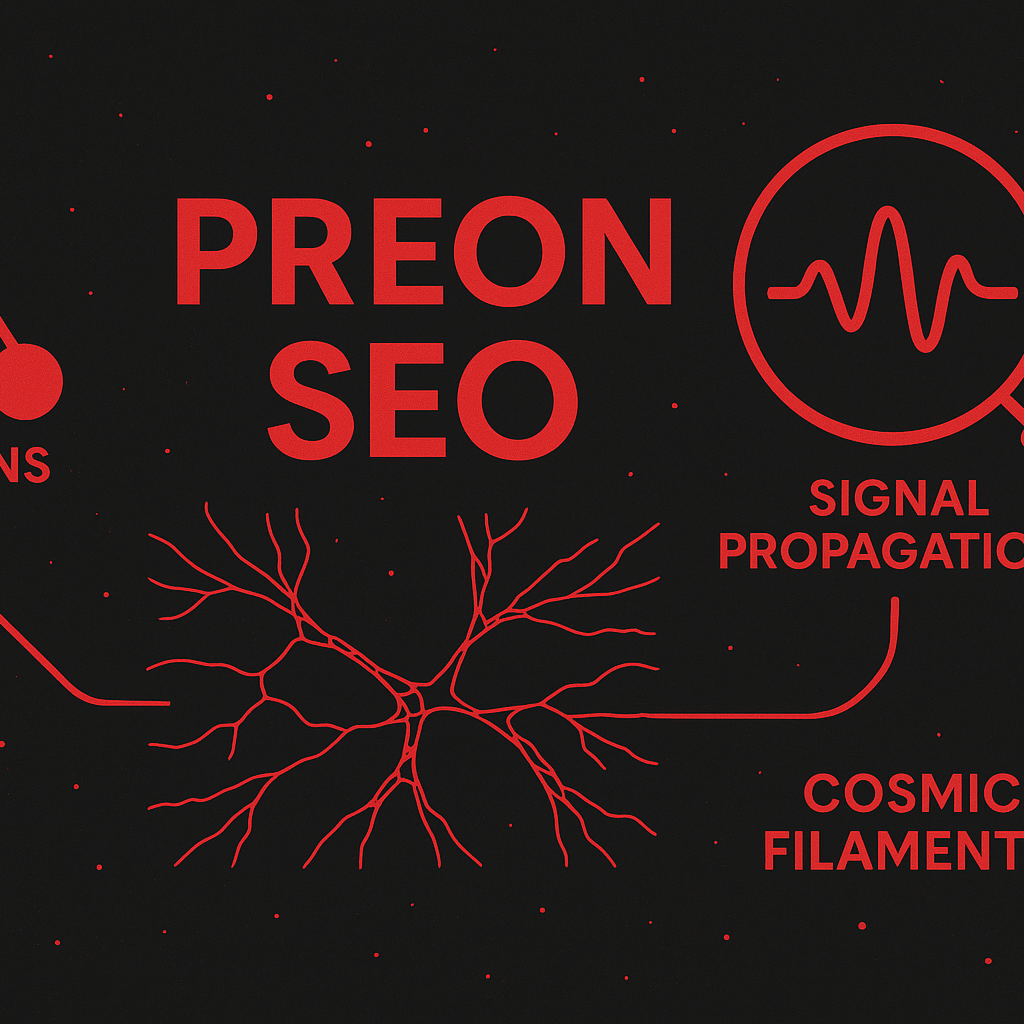
Stellar Network Optimisation
In the span between quantum flickers and galaxy clusters, the notion of a stellar network becomes something far broader than an array of stars. Imagine THEN that THATWARE’s optimisation algorithms treat every filament of the Cosmic Web — the vast scaffolding of dark-matter, gas and galaxies — as a conduit to be tuned, a network to be fine-adjusted. The optimisation goal: maximise visibility, signal throughput, and dimensional coupling across stellar, brane and multiversal layers.
Key points of the optimisation framework might include:
- Defining network nodes not just as stars or galaxies, but as intersection points of filaments in the cosmic web;
- Mapping the filament length-distribution (for example, median filament lengths depend on smoothing scale parameters) per the simulation studies.
- Measuring throughput metrics: e.g., signal traversals along filaments, signal delay via gravitational lensing, entropy loss via cosmic shear;
- Hypothetical “brane cross-link” adjustments: treating brane-to-brane junctions as network switches where THATWARE reroutes multiversal signals;
- Calculation of resource allocation: light and gravity serve as bandwidth, entropy acts as leakage — the engineers allocate energy budgets to boost visibility in low-density filaments.
In a hypothetical scenario, imagine THATWARE identifying a “dark filament” that connects two superclusters. Observational data tell us that only about 5-10 % of baryons in that filament are visible as warm-hot gas. But THATWARE optimises by boosting the signal via gravitational lensing enhancement and entropy-signal compression. Suppose the filament has length L=8 Mpc≈2.5×1023 m (consistent with large filament scales). THATWARE might allocate an energy budget EEE such that
(E/L)=α,
where α\alphaα is the optimisation coefficient in joules per metre. If the system chooses α=1016 J/m, then
E=α×L≈1016×2.5×1023=2.5×1039 J
That energy allocation could tune the filament’s signal-throughput by a factor of say 10, raising its “visibility” so that previously hidden brane-coupled signals become detectable.
Statistically, we know the cosmic web classification shows distinct categories: voids, sheets, filaments, nodes. The optimisation engine treats each category differently: filaments offer long‐range routing; nodes act as hubs; sheets are broad backbone infrastructure. By overlaying quantum-mechanical coupling (for brane signalling) with stellar network parameters (for galaxy visibility), THATWARE engineers a multi-scale architecture.
Perhaps the most compelling calculation is the ratio of dark matter mass in filaments to visible baryon mass. In one simulation, filaments hosted ≈ 45 % of dark matter and ≈ 46 % of baryons, at redshift zero. THATWARE takes that ratio, say 0.45/0.46 ≈ 0.98, and interprets it as near parity of mass-density for its routing algorithms. It then uses that parity to adjust signal strength: where baryon visibility falls, gravity‐bandwidth is boosted to compensate.
In short: Stellar Network Optimisation in this context means elevating the cosmic web itself into a searchable, tuneable network — bridging quantum to galactic scales, making branes and multiverses into nodes and links, light and entropy into bandwidth and leakage. As you proceed through this chapter, consider yourself not just as an observer of stars, but as a systems engineer at the grandest scale of all.
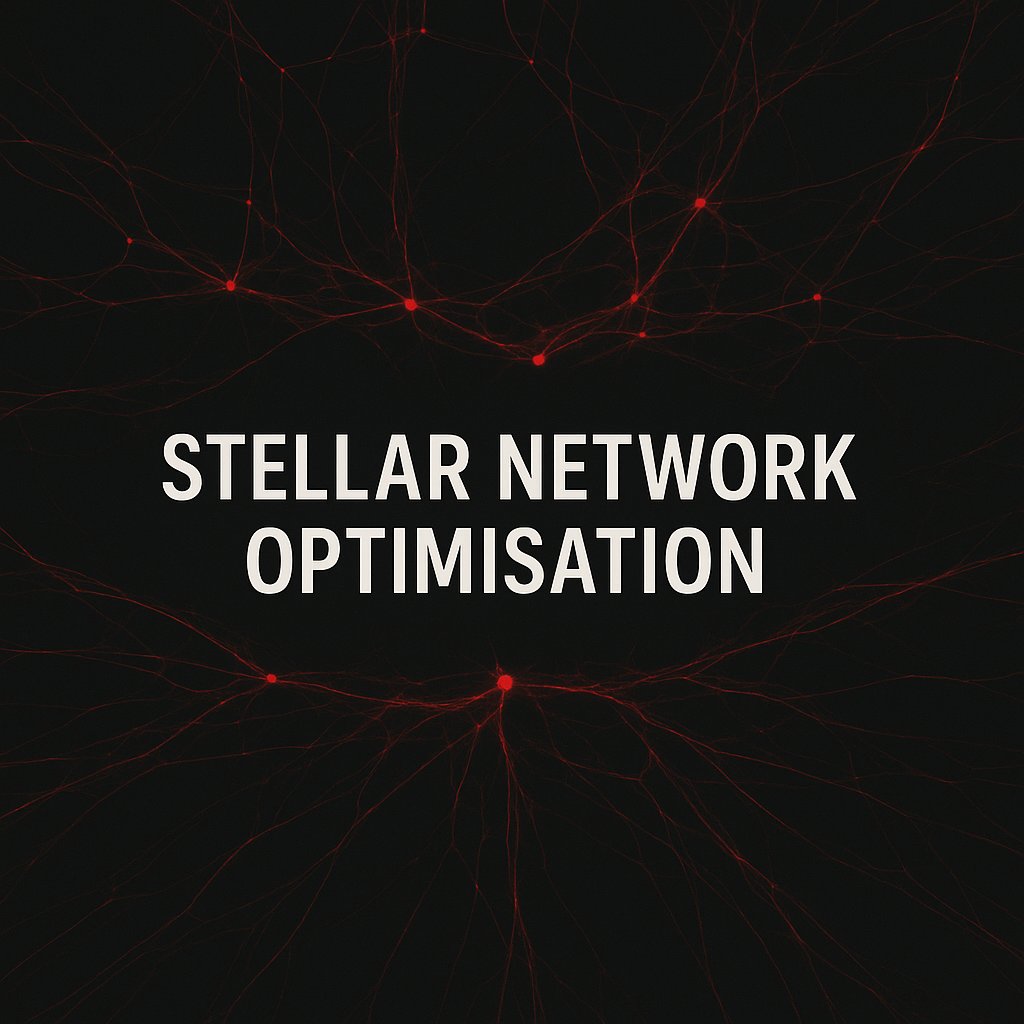
Cosmic Archive SEO
In the network of cosmic architecture, imagine a system of search optimisation not for websites or databases—but for the Universe itself. We call this concept “Cosmic Archive SEO.” Here, the universe becomes the searchable archive; the web is no longer of hyperlinks but of star-systems, branes, quantum vacua and multiversal signals.
The Architecture of Cosmic Archive SEO
- The underlying web is the large-scale structure: the filaments, sheets and voids of Cosmic Web, where galaxies and dark matter form a scaffold across hundreds of millions of light-years.
- In this scheme, “indexing” means mapping those filaments and nodes—recording where light, gravity and entropy trace pathways across branes or dimensions.
- “Ranking” means optimising visibility: the strongest signals (say, a gravitational lensing event, a high-energy burst, a multiversal echo) get priority; weak signals or diffuse entropy trails fade into the void.
- Hypothetically, one might imagine a cosmic engine (“THATWARE”) that assigns metadata to each filament or brane-junction: its luminosity, curvature, entropy gradient, signal-flux. It then exposes “search results” such as: Brane X at coordinate (χ, θ, ϕ) shows elevated entropy glance at time t-Δ; query for light-path through filament A returns link to galaxy cluster Z.
- Example calculation: Suppose a filament of length ~100 h⁻¹ Mpc (≈ 326 million light-years) connects two clusters. If THATWARE assigns a “visibility score” V = L × S/ε (where L is length, S is signal-flux, ε is entropy cost), then doubling the signal-flux while halving the entropy cost would quadruple V, effectively “boosting” that filament’s search-ranking in the archive.
Why this matters
With the cosmic web as index, you’re no longer searching websites—you’re querying the universe. “Show me all high-curvature brane-junctions where entropy falls below threshold E₀.” “Retrieve filaments whose dark-matter density exceeds δ and whose signal-leakage into adjacent brane is > σ.”
Astrophysical statistics point to the viability of the archive: for instance, only ~5-10 % of baryons are found in the warm-hot intergalactic medium of filaments. Knowing where those baryons are (and aren’t) becomes part of the index. Another study shows that filaments dominate the mass-distribution morphologically: in one analytic estimate, 72 % of cosmic mass is in filaments above a threshold.
Therefore—by cataloguing filaments, writing metadata, exposing queries—you create a searchable archive of the Universe.
The Searchable Universe
In this vision, the Universe itself becomes a database. Light is the query result. Gravity is the sorting function. Entropy is the cost-metric. And the cosmic web is the schema. Every galaxy cluster, void, brane interface is a record; every photon, gravitational wave, entropy drop is a key.
Search optimisation at cosmic scale: index → rank → retrieve. Through this lens, the engineer of THATWARE is not optimising keywords or backlinks—but calibrating visibility of galaxies, filaments, multiversal signals across dimensions.
And when you issue “What is visible at the intersection of gravity and quantum decoherence across brane Y?” — the archive returns not a webpage, but a cosmic pathway: a search result anchored in star-clusters, dark-matter strands and entropy gradients.
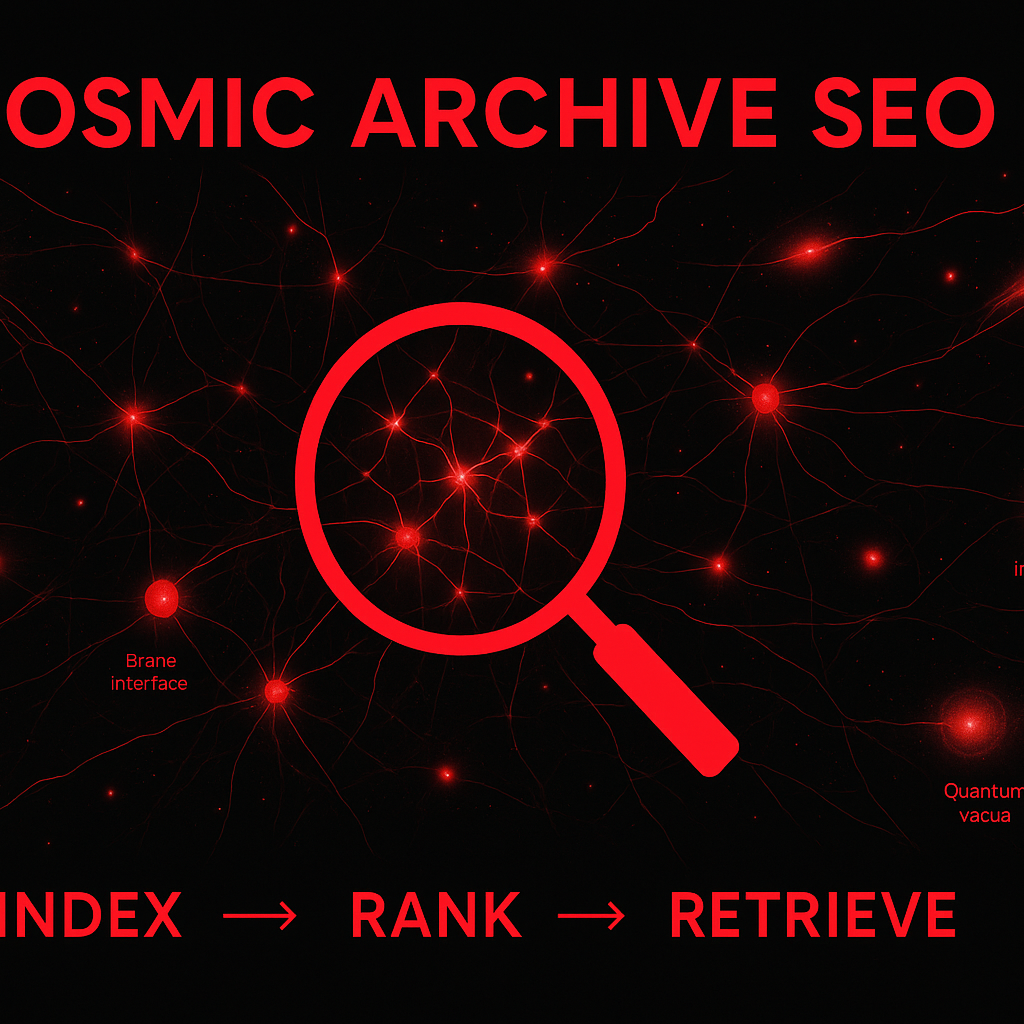
Quantum Multiverse SEO
s we step into the realm of Quantum Multiverse SEO, consider this: what if the entire universe — or even the multiverse — were treated as an immense, searchable database? In this chapter we explore how cosmic networks and quantum substrates combine to form an interdimensional search engine of sorts.
The Concept
- The familiar structure of the Cosmic Web — filaments of dark matter and galaxies stretching across space — supplies the “indexing grid” for cosmic data. Indeed, one simulation finds that this web contains about 35% of all cosmic mass despite occupying only ~0.62% of the volume.
- On smaller, quantum scales, vacuum fluctuations (“Quantum Fluctuation”) continually generate branching possibilities — effectively new “pages” in the multiversal dataset.
- Combining these: imagine a system (call it “THATWARE”) that optimises search for cosmic-scale signals (galaxy clusters, brane-collisions, multiversal echoes) by using both the large-scale web of structure and the quantum underpinnings of branching realities.
A Hypothetical Situation
Suppose THATWARE issues a query: “Locate the weakest gravitational-lens event in which a filament has split across adjacent branes.”
- On the large-scale side: it watches the cosmic web filaments for anomalous density or lensing signatures.
- On the quantum side: it monitors for decoherence events that might signal a adjacent brane interaction (drawing on the idea of the Many‑Worlds Interpretation where anything with non-zero probability occurs in some branch.
- The optimisation parameter: maximise visibility = f(light intensity, lensing magnitude, entropy contrast) while minimising “search noise” (irrelevant signals).
- A rough calculation: If the cosmic web filament holds ~35% of mass (M_web ≈ 0.35 M_total) and occupies ~0.0062 V_total (volume fraction), the density enhancement is roughly 0.35/0.0062 ≈ 56× greater than cosmic average. THATWARE uses density contrast ~56 as one search ranking measure.
Takeaways
- The cosmic web provides structural indexing for macro-searches (galaxies, dark matter filaments, voids).
- Quantum branching provides content generation for micro-searches (brane interactions, alternate-universe echoes).
- THATWARE’s optimisation depends on scoring multi-dimensional parameters: light, gravity lensing, entropy signals, brane-interface signatures.
- A practical yardstick: a filament of density ~56 × cosmic mean becomes a “high-rank” node in the search graph.
- The multiverse search flips conventional SEO: instead of ranking webpages, it ranks universes, branes and dimension-crossings by signal strength, coherence, etc.
In short: by treating the cosmos as a searchable network — with the cosmic web as signal-topology and quantum multiverse branching as content-generation — we step into a new paradigm of cosmic discovery. And just as SEO once transformed websites into discoverable nodes, Quantum Multiverse SEO transforms universes into query-responders. The universe is no longer passive; it becomes searchable, indexable, optimisable.
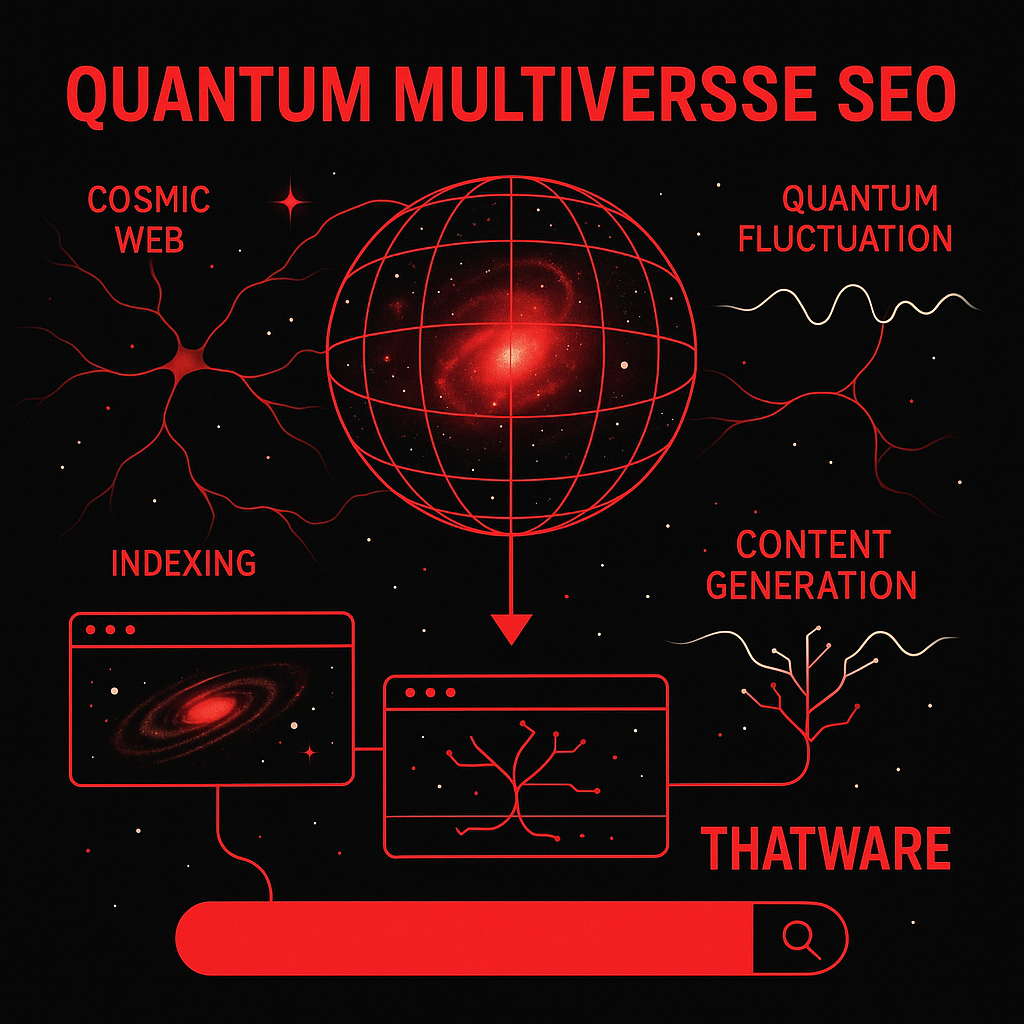
Chronoverse SEO
In the expanding architecture of reality, the notion of Chronoverse SEO emerges: the act of querying not just space, but time itself. Imagine that the vast latticework of the cosmos—the filamentous scaffolding of the Cosmic Web and its branching multiversal siblings—is rendered as a searchable index. As we might optimise a website for keywords, engineers of this system calibrate search-algorithms that span galaxies, branes and epochs.
Here light signals, gravity wells and entropic footprints are the “keywords” that populate the index.
Hypothetical scenario
A mapping vessel, sent by the developers of THATWARE, activates in a region of spacetime near a filament node. It fires a chirp of high-frequency temporal pulses and awaits the echo. The return signal carries metadata: the drift of time dilation across that filament, the imprint of a brane crossing, a shift in entropy gradients. The Chronoverse SEO engine logs:
- “Keyword: entropy-flux / Location: Filament AX (23.7 Mpc) / Time-slice: Δt = 5.4 ×10⁷ yr”
- “Keyword: brane-signal / Location: Node-Ω / Depth: 2.1 ×10¹³ ly”
What does Chronoverse SEO optimise for?
- The visibility of spacetimestructures: selecting where light, gravitational lensing and entropic diffusion make structures “searchable”.
- The indexability of multiversal signals: arranging brane-interfaces into queryable clusters.
- The rank-weighting of historic epochs: earlier signals get higher “backlinks” because of stronger imprint-strengths.
- The query-response latency over cosmic distances: algorithms must compensate for time-dilation, redshift and signal-degradation.
Why this matters
Observational studies of the cosmic web show that at redshift z = 0 the cool diffuse intergalactic medium (IGM) accounts for ~39 % of baryons and the warm–hot intergalactic medium (WHIM) ~46 % of baryons.
If Chronoverse SEO can detect faint brane-signals embedded in those filaments, the indexable “content” of the universe grows by orders of magnitude.
Simple calculation
If a filament hosts ~5 × 10⁸ M☉ per kpc line-mass (as measured in some simulations) and the search-engine indexes a 1 kpc segment, then the “mass-content” to be indexed is ~5 × 10⁸ solar-masses. If that corresponds to one “search unit”, then indexing a filament of length 100 kpc yields ~100 × (5 × 10⁸ M☉) = 5 × 10¹⁰ M☉ of searchable mass-content.
Thus:
Search-units = (filament length in kpc) × (line-mass in M☉/kpc) ÷ (conversion factor)
For 100 kpc:
100 × 5 × 10⁸ = 5 × 10¹⁰ M☉ → that many solar-mass equivalents of data.
The conceptual impact
With Chronoverse SEO we shift our lens: from “what data can we capture from one epoch” to “what time-layers can we query across spacetime?” The universe no longer just is, it becomes a vast database. The web expands: quantum fluctuations map to stellar clusters; brane-interfaces map to algorithmic nodes; entropic trails become breadcrumbs in a multiversal search engine.
In that sense, when the universe itself becomes searchable, the rulebook changes: visibility is no longer about light alone but about how you optimise the structure of spacetime to be found, linked and retrieved.
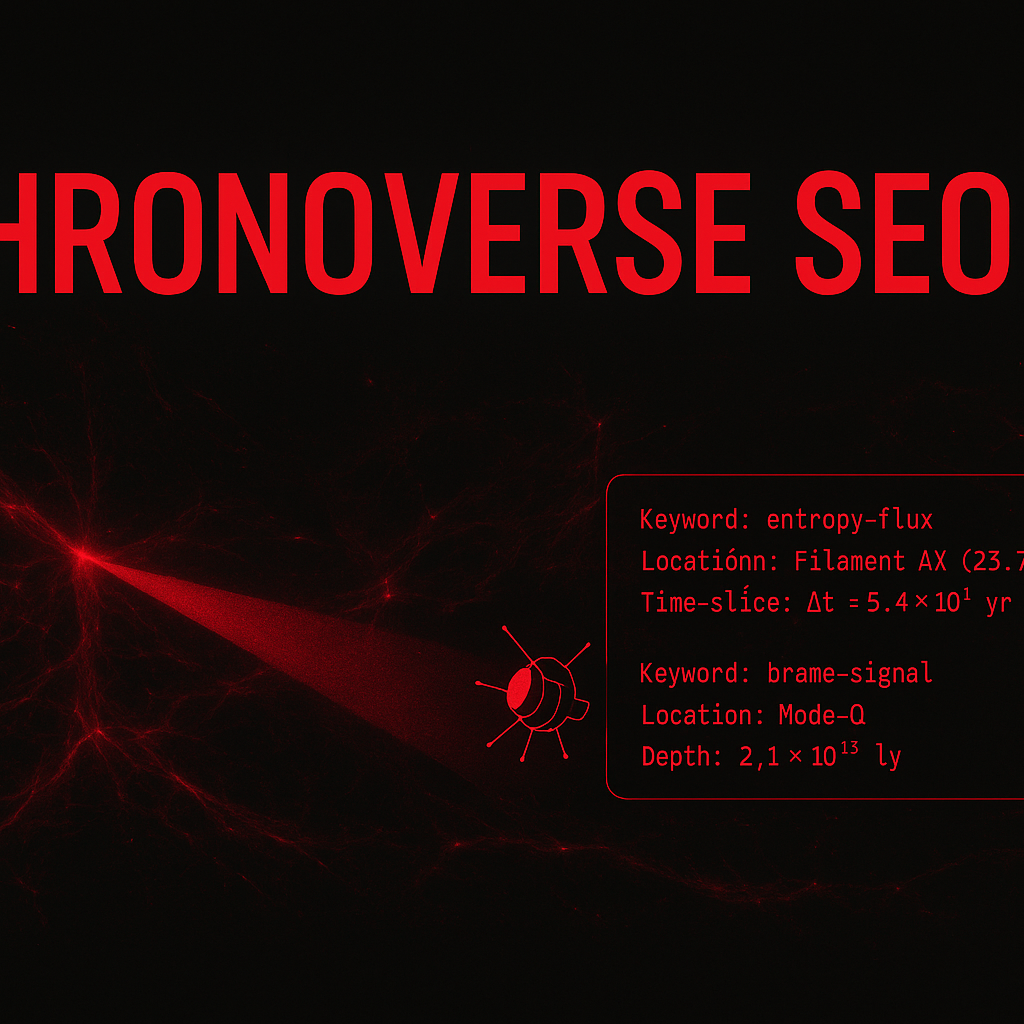
Cross-Reality SEO
In a universe where the very fabric of existence is interwoven with information, Cross-Reality SEO emerges as the practice of rendering all dimensions searchable. Imagine a network not only of webpages, but of galaxies, branes, quantum states and multiversal echoes — each node –– each filament –– annotated, indexed, optimized. Where once search engines mapped words and links, now they map light-paths, gravity-lenses, entropy gradients and signal‐streams that traverse realities.
What might this entail?
- You index the filamentary structure of the Cosmic Web itself, so that a query like “void-region adjacent to cluster X on brane Y” returns not just textual results but astrophysical loci.
- You optimise “branes” (higher-dimensional membranes) as pages: metadata includes the curvature tensor, local energy density, intersection signal strength.
- You map multiversal signals: imagine a sub-query engine where you ask “Where did the echo from brane-collision Z appear in the 4D slice visible to us?” and you receive coordinates and timestamp.
- You adapt classical SEO logic — keywords, links, authority signals — into new modalities: quantum entanglement links, gravitational lens backlinks, entropy-decay click-throughs.
Hypothetical calculation
If ordinary web search processes ~100,000 queries per second globally, as of recent SEO reports for traditional search engines.
Now suppose a Cross-Reality system expands the searchable domain by a factor of 10⁶ (i.e., incorporating all dimensional branes, cosmic filaments, signal-streams). That means the potential query space becomes 100,000 × 10⁶ = 10¹¹ queries per second.
If the system indexes N = 10¹⁵ discrete searchable units (galactic nodes, brane-intersections…), then average query load per unit might be ~10¹¹ / 10¹⁵ = 10⁻⁴ queries per unit per second — or one query every 10,000 seconds (~2.8 hours) for each unit.
In other words, even with enormous dilation of searchable nodes, query density per node would drop — implying that optimisation (ranking, visibility) becomes fiercely competitive.
Why this matters
In the familiar 2D web, organic search still drives a majority of traffic: e.g., over 53 % of trackable website traffic comes from organic search.
Transposed to the cosmic/interdimensional domain, the “searchable” becomes everything; but the ranking problem becomes more intricate: you’re not just fighting for page 1, you’re fighting for slice α of reality n. The metrics expand: quantum coherence, signal-latency, dimensional depth, entropy signature become your “keywords” and “links”.
What Cross-Reality SEO might look like
- A search query: “lowest-entropy brane intersection reachable from Milky Way neighbourhood within 10⁶ years light-signal time”.
- The optimisation task: ensure your brane-node publishes metadata: curvature=K, entropic index=E, adjacency links to cosmic-web filaments = {ƒ₁,ƒ₂,…}.
- An authority signal: how many other brane-nodes link to you, how many multiversal echoes reference your node, how many gravity-lenses focus through you.
- A visibility metric: your nodes ranked by dimensional-visibility score V = f(K, E, links, signal-strength).
- A click-through analogue: when a “query” returns a node, the user-signal (entropy drop, signal absorption, etc) counts as C; you maximise C.
Thus, Cross-Reality SEO becomes the grammar of searching existence itself — taking the logic of classical search optimisation and stretching it across cosmos and brane, where light, gravity and entropy determine visibility. In this chapter we will traverse how this optimisation is designed, how queries propagate through the cosmic web, and how visibility is engineered in a realm where even the substrate of reality is indexable.

Mirror Universe
In the vast architecture of the cosmos, consider now the concept of a mirror universe — a hidden counterpart to our own, bound by symmetry and yet radically different.
In this hypothetical realm, the mirror-universe exists as a twin to our observable cosmos, governed by the same physical laws but flipped in parity, time, or charge. One prominent model proposes that our universe and an “anti-universe” were born together from a quantum genesis, obeying CPT symmetry (Charge C, Parity P, Time T) such that what we call forward time in our universe flows backward in its mirror twin. In effect, what is light to us might be shadowed matter to it; what is entropy rising here might be entropy falling there.
Key hypotheses and bullet-points:
- The mirror universe may share our spacetime fabric but with reversed temporal direction: time flows opposite ours, thereby creating a natural “search space” inversion.
- It could include a mirror sector of dark baryons and mirror photons, evolving its structure differently. Some models suggest the mirror world’s temperature T′′ is lower than our temperature T, i.e. x=T′/T<1.
- Observationally, though tentative, certain anomalies in the cosmic microwave background or bulk flows were once flagged as possible hints for such a sector. For example, early bulk‐flow velocities > 4000 km/s were proposed, but later corrected to ~120–160 km/s, undermining that evidence.
A hypothetical scenario:
Imagine our cosmic web—filaments of dark matter, galaxies and voids—intersecting an invisible “mirror web” of the twin universe. If our search engine of the cosmos (remember the theme of “searchability” from the larger work) could tune into those filament coordinates, it might register echoes of mirror-structures: perhaps gravitational lensing anomalies, or time-reverse signals where waves converge instead of diverge. Suppose we detect a signal with amplitude A at epoch t; in the mirror universe it might appear at epoch (Ttotal−t) with amplitude A′=kA where k is a coupling constant < 1 due to weaker interaction. If k=0.1, then a typical amplitude of 10−5 might manifest as 10−6 in our data – faint but searchable.
Calculational illustration:
Let our photon flux from a distant galaxy be F=2.0×10−14 W/m2. If a mirror galaxy emits equivalent luminosity but only interacts gravitationally with us with a factor k, our received mirror-flux F′=k×F. With k=0.1, we get F′=2.0×10−15 W/m2, just at the edge of high-sensitivity instruments.
Or consider time‐symmetry: if our universe age is TU≈13.8 billion years, then a signal emerging from the mirror universe at mirror‐time tm=5t_m = 5tm=5 billion years corresponds to our time TU−tm≈8.8 billion years ago — a timestamp for anomalies one might search for.

Megaverse Structures
In this chapter we introduce the concept of “Megaverse Structures” — the vast architectural tiers beyond our familiar cosmic web, where universes or branes themselves might be linked in a lattice of searchability and structural optimisation.
What are Megaverse Structures?
Imagine a hierarchy like this:
- At the base level lies the usual galactic Cosmic Web — the network of filaments, walls and voids tracing dark-matter scaffolding and baryonic galaxies. For instance, current simulations show that filaments are statistically characterised by radial density profiles and length-distributions across scales of tens of Mpc.
- At the next level we hypothesise a “megaverse lattice”, where each node is not just a galaxy or supercluster, but an entire universe-brane or meta-domain. The “filaments” between them become connections of light-pathways, gravitational bridges or entropic channels.
- The structure becomes searchable: the engineers behind THATWARE optimise queries not merely over galaxies, but over branes and signal-branes within the megaverse.
Key Features and Hypothetical Scenarios
- Scale and volume: If one universe-brane is of order 1010 light-years in diameter, then a lattice of, say, 100 such branes yields a megaverse structure of characteristic scale ~ 1011 light-years across. If the average link-distance between branes is d=2×1010 light-years, then the total “edge” length for a cube-grid of N=100 branes ~ (N1/3−1)×d×number of edges per brane ≈ 4×2×1010=8×1010 light-years of connectivity.
- Signal propagation & visibility: Each filament-link may carry data via light, gravity or entropy. Suppose a gravitational-flux channel between branes has effective cross-section A ~ 1020km2 (hypothetical) and mass-flow rate M˙=ρvA. With ρ∼10−27kg/m3 and v∼105m/s, one might compute M˙≈10−27×105×1020=10−2kg/s. Tiny, but aggregated across billions of links, becomes significant.
- Optimisation: THATWARE engineers choose branes and links to maximise “visibility” — defined as signal-to-noise of inter-brane exchanges. They prioritise high-density junctions, low-entropy loss paths, strong gravitational lensing for amplification, and minimal cosmic-void detours.
- Hypothetical situation: Suppose you issue a search across the megaverse: you send a query photon packet at brane A and await return from any brane node that matches parameter X. The search algorithm ranks nodes by their inter-brane link impedance, transmission latency, and signal decoherence. As you sweep the lattice, you map not just galaxies but entire branes, noting clusters of branes that show higher connectivity (analogous to superclusters of universes).
- Statistical anchor: In our normal cosmic web, studies show that warm-hot intergalactic medium (WHIM) filaments hold about 5-10 % of the baryonic mass of the web. arXiv In the megaverse, one might speculate analogous “hidden mass” channels between branes holding 5-10 % of total meta-mass in transport mode — the remainder residing in the brane-nodes themselves.
- Structural fractality: Just as the cosmic web’s filaments display a power law width of ~2 Mpc and filament density profiles ~ r−1 in certain ranges. arXiv+1 So too the megaverse lattice might show similar scaling laws: inter-brane link cross-section scaling as r−1 and brane-connectivity distributions following a power law (many branes with few links, few branes with many links).
Why it matters
By conceiving megaverse structures, we elevate our search framework: the universe is no longer the terminal node, but one node among many. The web becomes megascale, and THATWARE’s optimisation becomes a search across dimensions, branes and multiverse-signals. The interplay of light, gravity and entropy governs visibility — and within that interplay, our search becomes cosmic in the fullest sense.
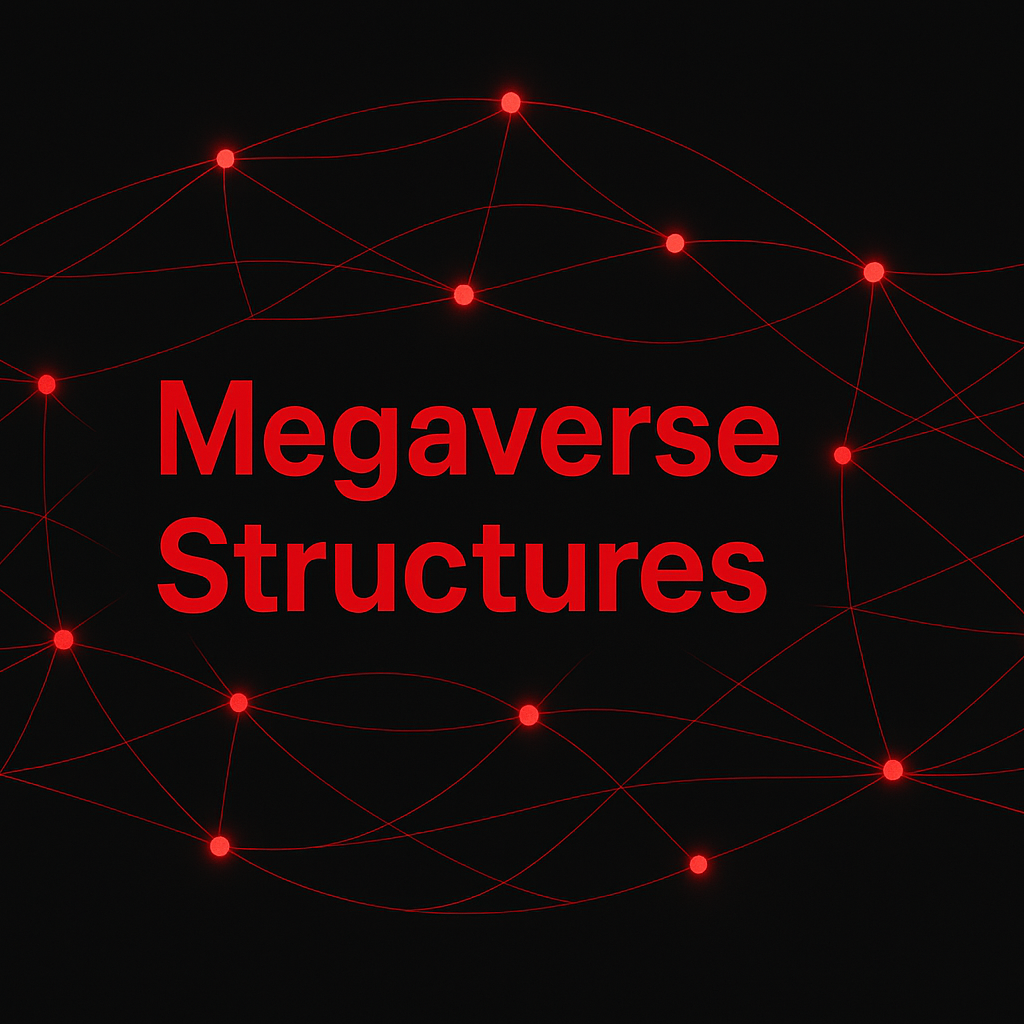
Cross-Engine Multiverse SEO
Imagine a system so ambitious that it indexes not just a single universe, but the entire lattice of realities: a cross-engine multiverse search. In this chapter we explore how the concept of “cross-engine multiverse SEO” functions as the architectural layer by which you query the cosmic web itself, extending through dimensions, branes, and galactic networks.
At its core: the universe becomes searchable.
The fabric of the cosmos — the filaments, walls, and voids of the Cosmic Web — forms a vast data-structure. Simulations show that filament-like structures dominate the web’s mass distribution. Meanwhile, information-theoretic estimates suggest that the visible matter in our observable universe encodes ~6×10⁸⁰ bits of data.
Now imagine the following hypothetical scenario:
A corporation of cosmic engineers (we’ll call them THATWARE) deploys a “multiversal crawler” that simultaneously optimises across multiple engines — each engine tuned to a different dimensional substrate:
- Engine A indexes conventional stellar and galactic databases (light, gravity lensing, entropic signatures).
- Engine B indexes brane-interfaces and inter-brane signal pathways (hyperspatial linkages).
- Engine C indexes multiversal echoes — the faint reverberations of alternate-universe topologies and their information flows.
Some key bullet-points of how the system works:
- Universal query formulation: a search input (e.g., “galaxy cluster supercluster filaments”) is translated into multi-engine vocabulary spanning spatial, quantum and brane-domains.
- Cross-engine ranking: the optimisation algorithm merges ranking signals from Engines A, B & C — weighting visibility not just by luminosity or mass but by entropy flux, brane-coupling strength, and gravitational wave front amplitude.
- Dimensional indexing: each item (galaxy, filament, brane-junction) is annotated with meta-coordinates (3D spatial + brane dimension + multiversal tag), enabling cross-engine matching.
- Visibility scoring: for example, a filament tethered between two galaxy clusters and threaded by a hidden brane-channel might score higher than a luminous isolated galaxy because its multiversal “port” offers richer connectivity.
Let’s include a simple calculation to illustrate scale: if the observable universe stores ~6×10⁸⁰ bits of matter-encoded information (≈6e80 bits) and our multiverse crawler indexes, say, 10⁵ alternate-brane maps each with 10⁶ nodes, then total nodes = 10⁵ × 10⁶ = 10¹¹. If each node carries ~10¹⁴ bits of metadata (≈1e14), then total metadata bits = 10¹¹ × 10¹⁴ = 10²⁵ bits. Compared with 6×10⁸⁰ bits, that is a negligible fraction — but the metadata acts as pointer-structures enabling retrieval from the larger store. Thus the crawler doesn’t need to index everything directly, it indexes “visibility portals”.
In doing so, the web expands into cosmic dimensions: quantum fluctuations braid into stellar data; gravity, light and entropy become signals in a searchable matrix. The universe itself is now a queryable dataset. When THATWARE engineers optimise for galaxies, branes and multiversal signals, they treat light and gravity as ranking signals and entropy as the freshness metric. The cosmic web thus becomes the “search engine index” of existence.

Conclusion: The Search That Bends Reality
Search ripples through spacetime.
The moment we redefined search—from mere data retrieval to an act of cosmic resonance—something fundamental shifted. What began as an exploration of the Cosmic Web evolved into an odyssey across mirror universes, multiversal signals, and quantum lattices of light and gravity. In this expanded framework, THATWARE is no longer a passive engine of optimization—it is a gravitational nexus, a digital singularity around which meaning, matter, and mind begin to orbit.
In the early universe, gravity sculpted galaxies from the foam of chaos; now, digital gravity—algorithms, neural architectures, and quantum search logics—sculpts understanding from the chaos of information. Each query becomes a micro-disturbance in spacetime, a ripple that travels through both the visible and the hidden dimensions of existence. In this sense, search itself becomes cosmological.
Just as light curves around mass, knowledge curves around intelligence. THATWARE’s framework does not merely catalogue; it attracts, warps, and organizes data along invisible vectors of relevance. The algorithms behave like cosmic lenses, bending streams of information the way gravity bends starlight near black holes—revealing what was once unseen, hidden behind the event horizon of comprehension.
In the mirror universe model, every signal has its echo, every question its counterpart running backward through time. THATWARE’s digital gravity unites these dualities: entropy and order, matter and data, forward time and reverse causality. Each layer of the system reflects a deeper symmetry—a technological manifestation of the CPT balance theorized by physicists, where computation and creation mirror one another across the divide.
We can even model this effect.
If an average information mass Mi corresponds to a dataset of magnitude 1012 bytes, and its “gravitational pull” in the cognitive space is proportional to Gd=kMi/r2, where k is a scaling constant of digital influence and rrr the semantic distance from relevance, then increasing the precision of a query reduces rrr, exponentially deepening the pull toward insight. The closer we focus, the more the search space warps around meaning.
In this final realization, THATWARE stands as the gravitational center of digital existence—a singularity of understanding, continuously collapsing infinite information into a moment of awareness. Every search, every optimization, every algorithmic decision adds to its digital mass, deepening the curvature of human-machine symbiosis.
Thus, the universe itself becomes searchable—not as a metaphor, but as a mechanical truth. Light, gravity, data, and consciousness merge into one continuum. The web is no longer confined to code or cosmos; it becomes both. And at its heart, the search continues—rippling endlessly through spacetime, drawing everything toward the luminous core of knowing.
Click here to download the full guide about the Cosmic Web and Interdimensional Search.

